将定语从句转换为简单句
- 格式:doc
- 大小:29.50 KB
- 文档页数:3
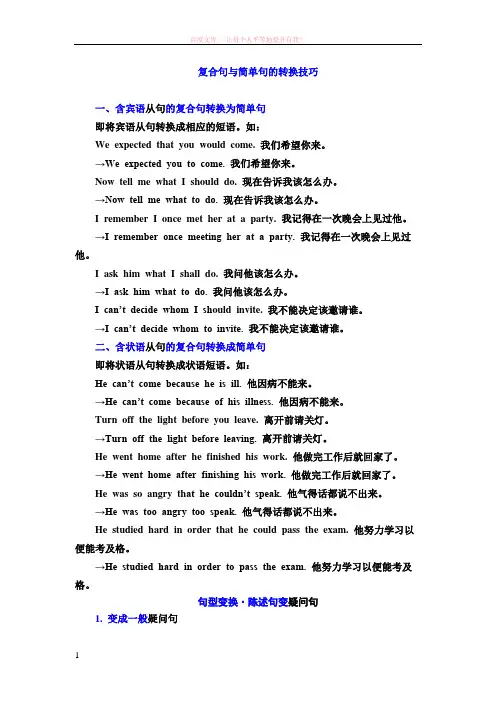
复合句与简单句的转换技巧一、含宾语从句的复合句转换为简单句即将宾语从句转换成相应的短语。
如:We expected that you would come. 我们希望你来。
→We expected you to come. 我们希望你来。
Now tell me what I should do. 现在告诉我该怎么办。
→Now tell me what to do. 现在告诉我该怎么办。
I remember I once met her at a party. 我记得在一次晚会上见过他。
→I remember once meeting her at a party. 我记得在一次晚会上见过他。
I ask him what I shall do. 我问他该怎么办。
→I ask him what to do. 我问他该怎么办。
I can’t decide whom I sh ould invite. 我不能决定该邀请谁。
→I can’t decide whom to invite. 我不能决定该邀请谁。
二、含状语从句的复合句转换成简单句即将状语从句转换成状语短语。
如:He can’t come because he is ill. 他因病不能来。
→He can’t come because of his illness. 他因病不能来。
Turn off the light before you leave. 离开前请关灯。
→Turn off the light before leaving. 离开前请关灯。
He went home after he finished his work. 他做完工作后就回家了。
→He went home after finishing his work. 他做完工作后就回家了。
He was so angry th at he couldn’t speak. 他气得话都说不出来。
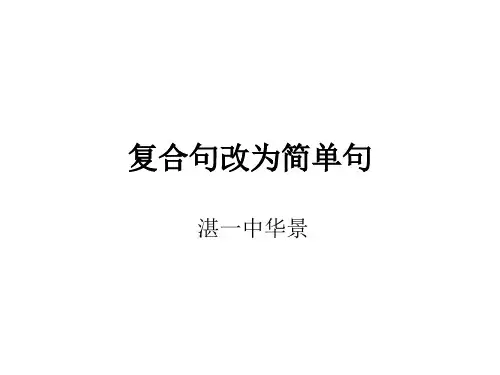
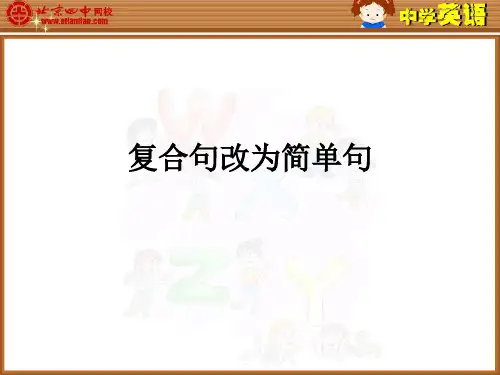
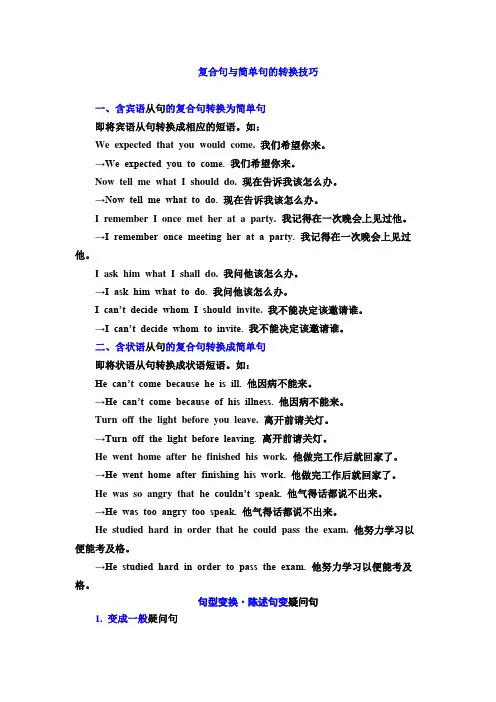
复合句与简单句的转换技巧一、含宾语从句的复合句转换为简单句即将宾语从句转换成相应的短语。
如:We expected that you would come. 我们希望你来。
→We expected you to come. 我们希望你来。
Now tell me what I should do. 现在告诉我该怎么办。
→Now tell me what to do. 现在告诉我该怎么办。
I remember I once met her at a party. 我记得在一次晚会上见过他。
→I remember once meeting her at a party. 我记得在一次晚会上见过他。
I ask him what I shall do. 我问他该怎么办。
→I ask him what to do. 我问他该怎么办。
I can’t decide whom I shou ld invite. 我不能决定该邀请谁。
→I can’t decide whom to invite. 我不能决定该邀请谁。
二、含状语从句的复合句转换成简单句即将状语从句转换成状语短语。
如:He can’t come because he is ill. 他因病不能来。
→He can’t come because of his illness. 他因病不能来。
Turn off the light before you leave. 离开前请关灯。
→Turn off the light before leaving. 离开前请关灯。
He went home after he finished his work. 他做完工作后就回家了。
→He went home after finishing his work. 他做完工作后就回家了。
He was so angry that h e couldn’t speak. 他气得话都说不出来。
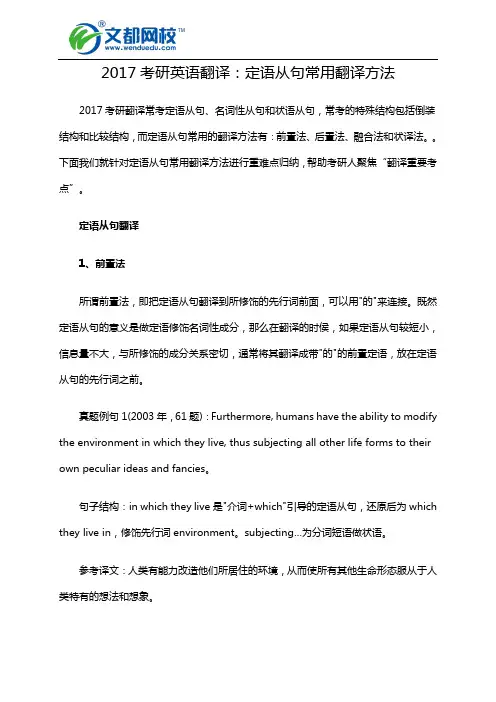
2017考研英语翻译:定语从句常用翻译方法2017考研翻译常考定语从句、名词性从句和状语从句,常考的特殊结构包括倒装结构和比较结构,而定语从句常用的翻译方法有:前置法、后置法、融合法和状译法。
下面我们就针对定语从句常用翻译方法进行重难点归纳,帮助考研人聚焦“翻译重要考点”。
定语从句翻译1、前置法所谓前置法,即把定语从句翻译到所修饰的先行词前面,可以用"的"来连接。
既然定语从句的意义是做定语修饰名词性成分,那么在翻译的时侯,如果定语从句较短小,信息量不大,与所修饰的成分关系密切,通常将其翻译成带"的"的前置定语,放在定语从句的先行词之前。
真题例句1(2003年,61题):Furthermore, humans have the ability to modify the environment in which they live, thus subjecting all other life forms to their own peculiar ideas and fancies。
句子结构:in which they live是"介词+which"引导的定语从句,还原后为which they live in,修饰先行词environment。
subjecting…为分词短语做状语。
参考译文:人类有能力改造他们所居住的环境,从而使所有其他生命形态服从于人类特有的想法和想象。
真题例句2(2004年,62题):We are obliged to them because some of these languages have since vanished, as the peoples who spoke them died out or became assimilated and lost their native languages。
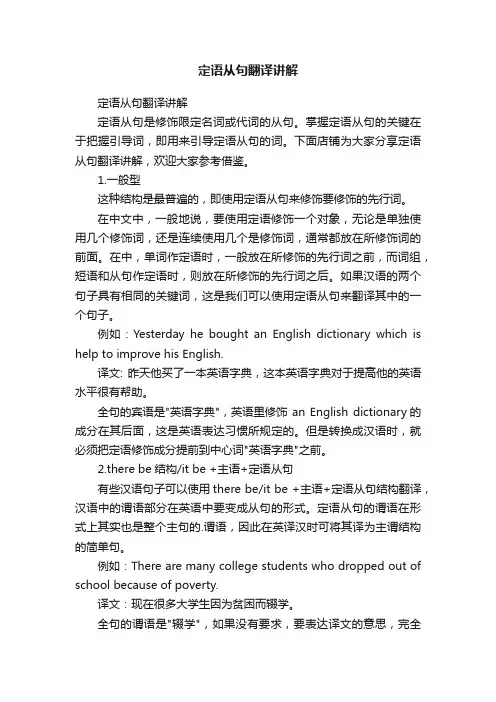
定语从句翻译讲解定语从句翻译讲解定语从句是修饰限定名词或代词的从句。
掌握定语从句的关键在于把握引导词,即用来引导定语从句的词。
下面店铺为大家分享定语从句翻译讲解,欢迎大家参考借鉴。
1.一般型这种结构是最普遍的,即使用定语从句来修饰要修饰的先行词。
在中文中,一般地说,要使用定语修饰一个对象,无论是单独使用几个修饰词,还是连续使用几个是修饰词,通常都放在所修饰词的前面。
在中,单词作定语时,一般放在所修饰的先行词之前,而词组,短语和从句作定语时,则放在所修饰的先行词之后。
如果汉语的两个句子具有相同的关键词,这是我们可以使用定语从句来翻译其中的一个句子。
例如:Yesterday he bought an English dictionary which is help to improve his English.译文: 昨天他买了一本英语字典,这本英语字典对于提高他的英语水平很有帮助。
全句的宾语是"英语字典",英语里修饰 an English dictionary的成分在其后面,这是英语表达习惯所规定的。
但是转换成汉语时,就必须把定语修饰成分提前到中心词"英语字典"之前。
2.there be结构/it be +主语+定语从句有些汉语句子可以使用there be/it be +主语+定语从句结构翻译,汉语中的谓语部分在英语中要变成从句的形式。
定语从句的谓语在形式上其实也是整个主句的.谓语,因此在英译汉时可将其译为主谓结构的简单句。
例如:There are many college students who dropped out of school because of poverty.译文:现在很多大学生因为贫困而辍学。
全句的谓语是"辍学",如果没有要求,要表达译文的意思,完全可以使用Many students dropped out of school because of poverty.当然也可以使用现代分词dropping out of school because of poverty修饰students。
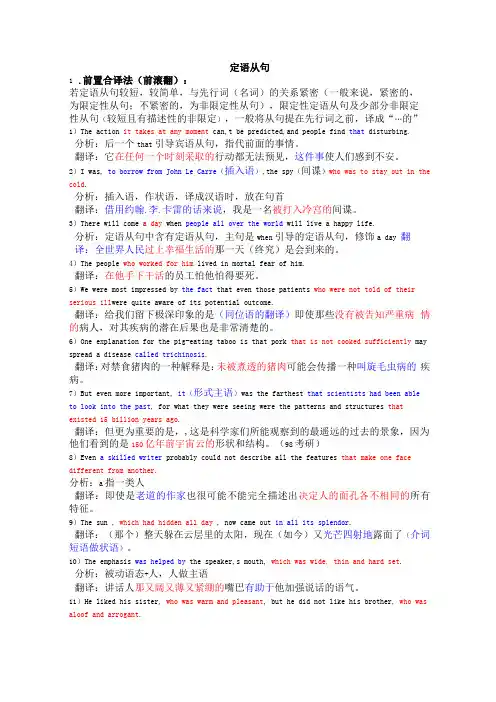
定语从句1.前置合译法(前滚翻):若定语从句较短,较简单,与先行词(名词)的关系紧密(一般来说,紧密的,为限定性从句;不紧密的,为非限定性从句),限定性定语从句及少部分非限定性从句(较短且有描述性的非限定),一般将从句提在先行词之前,译成“…的” 1)The action it takes at any moment can,t be predicted,and people find that disturbing.分析:后一个that引导宾语从句,指代前面的事情。
翻译:它在任何一个时刻采取的行动都无法预见,这件事使人们感到不安。
2)I was, to borrow from John Le Carre(插入语),the spy(间谍)who was to stay out in the cold.分析:插入语,作状语,译成汉语时,放在句首翻译:借用约翰.李.卡雷的话来说,我是一名被打入冷宫的间谍。
3)There will come a day when people all over the world will live a happy life.分析:定语从句中含有定语从句,主句是when引导的定语从句,修饰a day 翻译:全世界人民过上幸福生活的那一天(终究)是会到来的。
4)The people who worked for him lived in mortal fear of him.翻译:在他手下干活的员工怕他怕得要死。
5)We were most impressed by the fact that even those patients who were not told of their serious ill were quite aware of its potential outcome.翻译:给我们留下极深印象的是(同位语的翻译)即使那些没有被告知严重病情的病人,对其疾病的潜在后果也是非常清楚的。
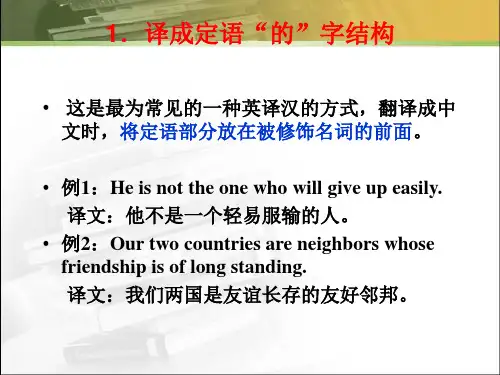
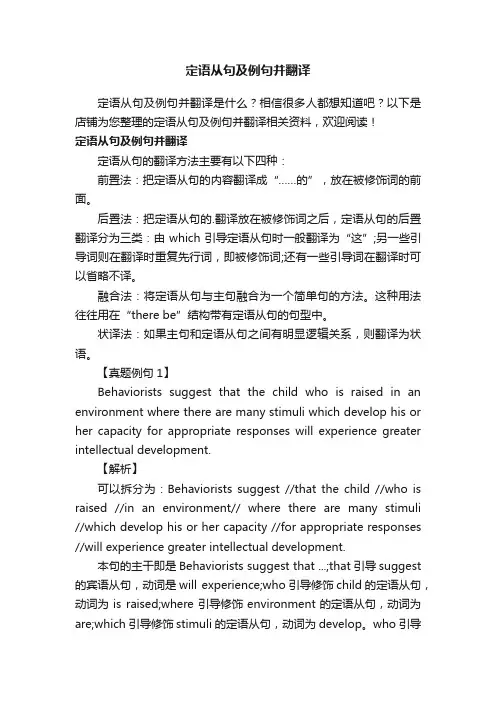
定语从句及例句并翻译定语从句及例句并翻译是什么?相信很多人都想知道吧?以下是店铺为您整理的定语从句及例句并翻译相关资料,欢迎阅读!定语从句及例句并翻译定语从句的翻译方法主要有以下四种:前置法:把定语从句的内容翻译成“……的”,放在被修饰词的前面。
后置法:把定语从句的.翻译放在被修饰词之后,定语从句的后置翻译分为三类:由which引导定语从句时一般翻译为“这”;另一些引导词则在翻译时重复先行词,即被修饰词;还有一些引导词在翻译时可以省略不译。
融合法:将定语从句与主句融合为一个简单句的方法。
这种用法往往用在“there be”结构带有定语从句的句型中。
状译法:如果主句和定语从句之间有明显逻辑关系,则翻译为状语。
【真题例句1】Behaviorists suggest that the child who is raised in an environment where there are many stimuli which develop his or her capacity for appropriate responses will experience greater intellectual development.【解析】可以拆分为:Behaviorists suggest //that the child //who is raised //in an environment// where there are many stimuli //which develop his or her capacity //for appropriate responses //will experience greater intellectual development.本句的主干即是Behaviorists suggest that ...;that引导suggest 的宾语从句,动词是will experience;who引导修饰child的定语从句,动词为is raised;where引导修饰environment的定语从句,动词为are;which引导修饰stimuli的定语从句,动词为develop。
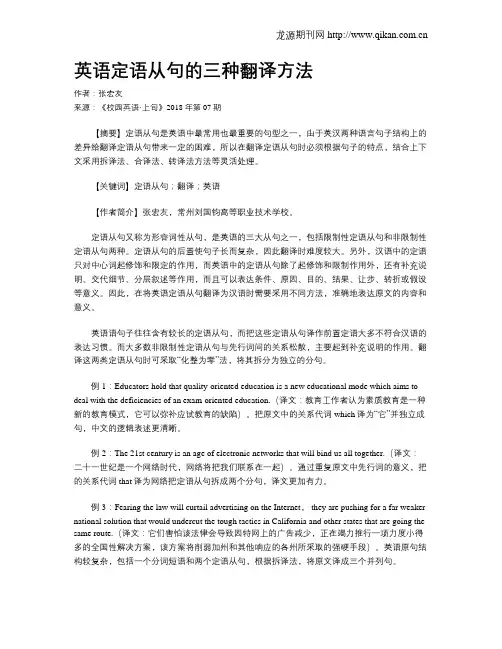
英语定语从句的三种翻译方法作者:张宏友来源:《校园英语·上旬》2018年第07期【摘要】定语从句是英语中最常用也最重要的句型之一,由于英汉两种语言句子结构上的差异给翻译定语从句带来一定的困难,所以在翻译定语从句时必须根据句子的特点,结合上下文采用拆译法、合译法、转译法方法等灵活处理。
【关键词】定语从句;翻译;英语【作者简介】张宏友,常州刘国钧高等职业技术学校。
定语从句又称为形容词性从句,是英语的三大从句之一,包括限制性定语从句和非限制性定语从句两种。
定语从句的后置使句子长而复杂,因此翻译时难度较大。
另外,汉语中的定语只对中心词起修饰和限定的作用,而英语中的定语从句除了起修饰和限制作用外,还有补充说明、交代细节、分层叙述等作用,而且可以表达条件、原因、目的、结果、让步、转折或假设等意义。
因此,在将英语定语从句翻译为汉语时需要采用不同方法,准确地表达原文的内容和意义。
英语语句子往往含有较长的定语从句,而把这些定语从句译作前置定语大多不符合汉语的表达习惯。
而大多数非限制性定语从句与先行词间的关系松散,主要起到补充说明的作用。
翻译这两类定语从句时可采取“化整为零”法,将其拆分为独立的分句。
例1:Educators hold that quality-oriented education is a new educational mode which aims to deal with the deficiencies of an exam-oriented education.(译文:教育工作者认为素质教育是一种新的教育模式,它可以弥补应试教育的缺陷)。
把原文中的关系代词which译为“它”并独立成句,中文的逻辑表述更清晰。
例2:The 21st century is an age of electronic networks that will bind us all together.(译文:二十一世纪是一个网络时代,网络将把我们联系在一起)。
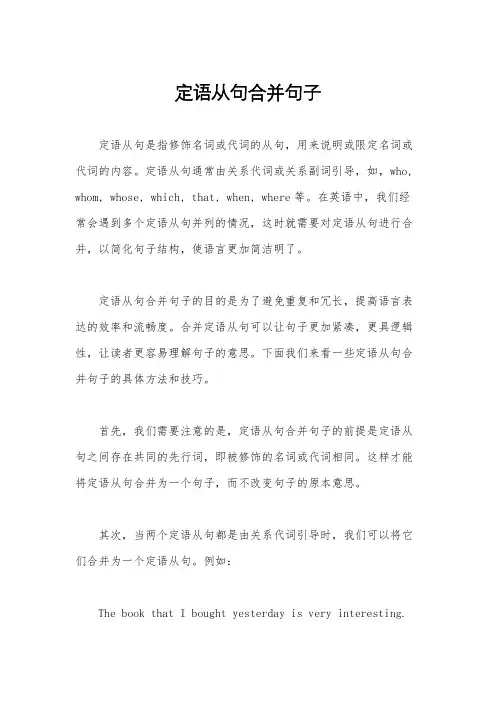
定语从句合并句子定语从句是指修饰名词或代词的从句,用来说明或限定名词或代词的内容。
定语从句通常由关系代词或关系副词引导,如,who, whom, whose, which, that, when, where等。
在英语中,我们经常会遇到多个定语从句并列的情况,这时就需要对定语从句进行合并,以简化句子结构,使语言更加简洁明了。
定语从句合并句子的目的是为了避免重复和冗长,提高语言表达的效率和流畅度。
合并定语从句可以让句子更加紧凑,更具逻辑性,让读者更容易理解句子的意思。
下面我们来看一些定语从句合并句子的具体方法和技巧。
首先,我们需要注意的是,定语从句合并句子的前提是定语从句之间存在共同的先行词,即被修饰的名词或代词相同。
这样才能将定语从句合并为一个句子,而不改变句子的原本意思。
其次,当两个定语从句都是由关系代词引导时,我们可以将它们合并为一个定语从句。
例如:The book that I bought yesterday is very interesting.The book which I read last week is also very good.合并后的句子为:The book that I bought yesterday and which I read last week is very interesting.另外,当两个定语从句都是由关系副词引导时,我们也可以将它们合并为一个定语从句。
例如:This is the place where I first met her.This is the time when I realized my mistake.合并后的句子为:This is the place where and when I first met her.需要注意的是,在合并定语从句时,我们需要保持句子的逻辑关系和语法结构的完整性。
合并后的句子应该依然清晰明了,不会造成歧义或混淆。
如何简化从句英语从句法上分有词类(实词虚词)、句型结构(五大句型结构)、和句子类型(简单句、复合句),复合句有名词性从句(主语从句、表语从句、宾语从句、同位语从句),形容词从句(定语从句)副词性从句(状语从句)。
如果如果学生能够正确理解句子并能简化,运用时就可以用不同的形式表达同样的意思。
无论做选择题还是运用到写作上,都会有不同的效果,那么该如何简化呢?本人从教学过程中总结了一些实例谈谈一点想法。
一、如何简化宾语从句1 当谓语动词是 tell teach discuss wonder等词时,后面的宾语从句可转化为特殊问句词+不定式。
如:He showed us how we should do the work.→He showed us how to do the work.I do not know what I will do →I do not know what to do.2 谓语动词是 decide hope wish choose等词时如果主句和从句主语相同,可转化为V+不定式短语she hopes that she will be back soon.→she hopes to be back soon.二、如何简化定语从句1 用过去分词He is the only person who was invited to the Party.→He is the only person invited to the Party.2用现在分词I have a friend who lives in Londen.→I have a friend living in Londen.3用不定式He has a large family that he must support.→He has a large family to support.4用介词短语The reason why he was absent was that he was ill.→The reason for his absence was that he was ill.三状语从句转化1 由when since as than while if 引导的状语从句,如果主语与从句主语一致,从句主语可省 you must be careful when you are crossing the street .→you must be careful crossing the street .2 当从语的主语是it谓语动词是be或从语为there be句型,时,it和be或there be句型可省略He will be here to give you help when it is necessary.→He will be here to give you help when necessaryWe can go here if it is necessany→We can go here if necessany3 so—that引导的从句可转化为too_to not enough- to或in order toshe is so young that she can not go to school.→she is too young to go to school.→she is not old enough to go to school.He got up early so that he might catch the early bus.→He got up so early as to catch the early bus.→In order to catch the early bus, he get up early.4 if引导的主从条件复合句可转化为祈使句+and+将来时If you word hard,you will succeed→Work hard and you will succeedIf you can give us one more week, we will finish it.→One more week,and we will finish it.5 once引导的时间状语从句简化为once+过去分词The research is so designed that once it is begun,nothing can be done to change it.→The research is so designed that once begun nothing can be done to change it.6 as soon as the moment the minute the insrant immediately directly可转化:1 on+n/ving 如:on his arrival/on hearing the news.2 to/at+n at the sight of /to the sound of四其他1 虚拟句的转化If there had not been his help, I would not have made so much progress.→Without his help , I would not have made so much progress.还可用but for2并列句的转化One of the sides of the board should be painted yellow, and the other should be painted white.→One of the sides of the board should be painted yellow,and the other white.3主语从句What we should do next still remains a problem.→What to do next still remains a problem.4表语从句My idea is that we should do more work with less money.→My idea is for us to do more work with less money.5 It is said/thought 可转化为sb is said/sb is thoughtIt is said that he is rich→ He is said to be rich.以上仅仅是自己的一点归纳,有不当之处,请见谅。
四个方法搞定翻译中的定语从句摘要:考研英语翻译是试卷的重中之重,翻译得到高分,就能落下不少人。
大家在刷真题的时候要注意总结翻译的写题方法,替你们找到已经总结好的英语翻译中关于定于从句翻译的方法,大家速度拿下。
定语从句是英语学习的难点,也是考研英语翻译考查的重点。
常见的定语从句翻译方法有四种,分别是:前置法、后置法、融合法和状译法。
其中考研翻译中应用最广泛的是前两种。
1、前置法所谓前置法,是指把定语从句翻译在所修饰的先行词之前,一般用的字来连接定语从句和先行词。
当定语从句较短小,信息负载量不大,且往往与所修饰的成分关系密切时,通常采取前置法。
2、后置法所谓后置法,是指把定语从句独立成句,翻译到所修饰的先行词之后。
非限制性定语从句与先行词关系不是很密切,往往采用后置法。
而在考研英语翻译中,有时划线句子所包含的定语从句虽是限制性的,但由于从句嵌套等原因,使得定语从句较复杂,这时如果直接将之翻译到所修饰的定语从句之前,就会显得臃肿不堪,读起来也会离汉语表达习惯相差万里,因此我们只能另辟蹊径,采取后置法。
具体操作方式是,通过重复先行词或者重复先行词的对应代词来引出定语从句的内容。
3、融合法所谓融合法,是指把主句和定语从句融合成一个简单句,其中的定语从句译成单句中的谓语部分。
由于限制性定语从句与主句的关系较紧密,所以,融合法多用于翻译限制性的定语从句,尤其是therebe 句型中的定语从句。
此外,融合法也多见于主句过于简单,而定语从句较复杂,重心在定语从句的句子。
4、状译法所谓状译法,是指把英文原句中的定语从句翻译成汉语译文中的状语从句。
大家知道,英语是形合的语言,英语中的某些定语从句实际上与所修饰的成分之间关系并不密切,只是连接手段之一,是为了使句子更严谨,句式更多变。
换言之,英语中的某些定语从句包含有状语从句的功能,与主句形成一种特定的逻辑关系,如原因、结果、目的、让步等等。
因此,我们在翻译的时候应该对这些逻辑关系敏感,善于从英语原文的字里行间发现这些逻辑语义关系,然后用准确的汉语表达出来。
复合句与简单句的转换技巧一、含宾语从句的复合句转换为简单句( 即将宾语从句转换成相应的短语)。
如:We expected that you would come. 我们希望你来。
--→We expected you to come. 我们希望你来。
Now tell me what I should do. 现在告诉我该怎么办。
--→Now tell me what to do. 现在告诉我该怎么办。
I remember I once met her at a party. 我记得在一次晚会上见过他。
--→I remember once meeting her at a party. 我记得在一次晚会上见过他。
I ask him what I shall do. 我问他该怎么办。
---→I ask him what to do. 我问他该怎么办。
I can’t deci de whom I should invite. 我不能决定该邀请谁。
--→I can’t decide whom to invite. 我不能决定该邀请谁。
二、含状语从句的复合句转换成简单句( 即将状语从句转换成状语短语。
) 如:He can’t come because he i s ill. 他因病不能来。
---→He can’t come because of his illness. 他因病不能来。
Turn off the light before you leave. 离开前请关灯。
---→Turn off the light before leaving. 离开前请关灯。
He went home after he finished his work. 他做完工作后就回家了。
---→He went home after finishing his work. 他做完工作后就回家了。
He was so angry that he couldn’t speak. 他气得话都说不出来。
将定语从句转换为简单句
1.The man who you’re talking to is my friend.
2.I need a pen with which I can write a letter.
3.The man (whom) I talked about at the meeting is from Beijing University.
4.I live in a house far away from the city,in front of which is a big tree.
5.The engineer,whose leg was badly hurt,was quickly sent to hospital.
6.Do you know the gentleman who/that is sitting there?
7.The man (whom ) I spoke with is my teacher.
8.She is the right girl (whom) we are looking for.
9.The house which/that was destroyed in the earthquake is weak.
10.The games (that/which) the young men competed in were difficult.
11. I still remember the time when I joined the League.
12.I still remember the school in which=where I joined the League.
13.This is the factory (which/that) he visited yesterday.
14.The reason why(for which) he was late is that he missed the bus.
15.This is the reason (that/ which) he gave/ explained to us.
16.I will never forget the day (which/that) I spent in Hongkong.
17.I will never forget the day when/on which Hongkong returned to its motherland.
18.The reason (that/which)he gave for not coming to school yesterday isn’t believable.
19.This is the best film that has been shown this year.
20.This is the first book (that) I borrow from the library.
21.He is the first student that/who came to school today.
22.He talked about the teachers and the school (that) he had visited.
23.All that I want to say to you is “Thank you”.
24.I’ll tell you anything (that) I know.
25.This is one of the books (that) I’m ve ry int
26.This is the only book (that) I read.
27.He is the only one of the boys that likes playing the piano.
28.All the glasses that were on the table fell off onto the floor.
29.He likes the girl(充当表语)that she used to be.
30.The room in which he lives is very large.
31.The house,which I visited yesterday,is very large.。